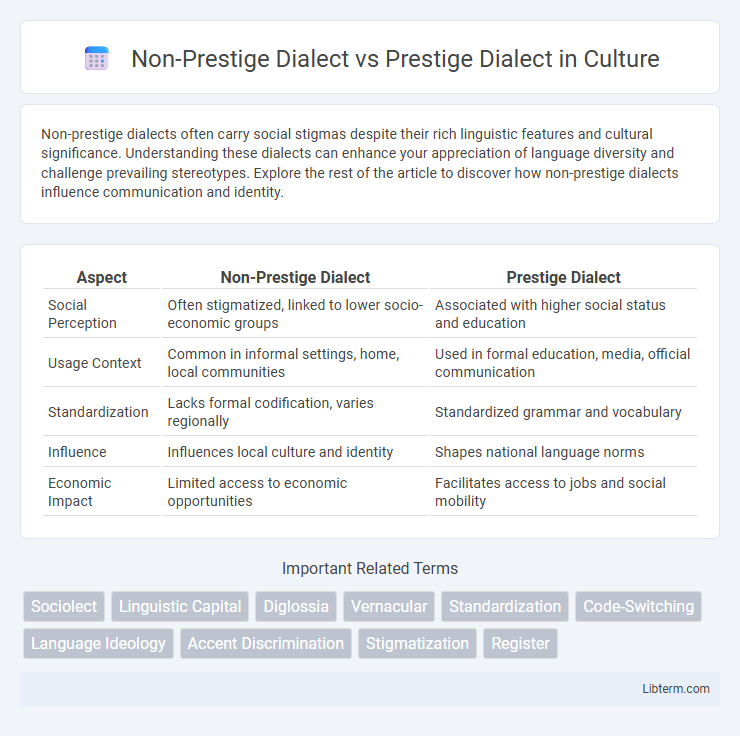Non-prestige dialects often carry social stigmas despite their rich linguistic features and cultural significance. Understanding these dialects can enhance your appreciation of language diversity and challenge prevailing stereotypes. Explore the rest of the article to discover how non-prestige dialects influence communication and identity.
Table of Comparison
| Aspect | Non-Prestige Dialect | Prestige Dialect |
|---|---|---|
| Social Perception | Often stigmatized, linked to lower socio-economic groups | Associated with higher social status and education |
| Usage Context | Common in informal settings, home, local communities | Used in formal education, media, official communication |
| Standardization | Lacks formal codification, varies regionally | Standardized grammar and vocabulary |
| Influence | Influences local culture and identity | Shapes national language norms |
| Economic Impact | Limited access to economic opportunities | Facilitates access to jobs and social mobility |
Introduction to Dialect Prestige
Prestige dialects are language varieties socially valued and associated with education, power, and higher socioeconomic status, influencing perceptions of speaker competence. Non-prestige dialects often reflect regional or cultural identity but may face stigmatization and limited social mobility implications. Understanding dialect prestige highlights the role of language in social stratification and identity construction.
Defining Prestige and Non-Prestige Dialects
Prestige dialects are language varieties associated with social power, higher education, and economic advantage, often viewed as the standard or "correct" form in a given community. Non-prestige dialects, in contrast, are varieties spoken by socially marginalized or less dominant groups, frequently stigmatized despite their linguistic complexity and cultural significance. These distinctions shape perceptions of authority, identity, and social mobility within sociolinguistic contexts.
Historical Roots of Dialect Hierarchies
Non-prestige dialects often emerge from marginalized communities and rural areas, reflecting historical patterns of social stratification and limited access to education and economic power. Prestige dialects originate from socially dominant groups, frequently shaped by political centers and institutions that enforce linguistic norms as markers of elite status. These historical roots establish dialect hierarchies, embedding language differences within broader contexts of class, power, and cultural authority.
Social Perceptions and Stereotypes
Non-prestige dialects often face negative social perceptions and stereotypes, being inaccurately associated with lower education, socioeconomic status, or lack of intelligence. Prestige dialects, conversely, are linked to higher social status, professionalism, and educational attainment, reinforcing social hierarchies and linguistic discrimination. These perceptions influence opportunities in employment, education, and social mobility, perpetuating inequality based on language use.
Linguistic Features of Prestige vs. Non-Prestige Dialects
Prestige dialects typically exhibit standardized grammar, richer vocabulary, and phonetic clarity aligned with socially dominant groups, while non-prestige dialects often feature regional lexicon, phonological variations, and syntactic structures divergent from the standard norm. Morphosyntactic differences in prestige dialects include prescriptive verb conjugations and formal sentence constructions, contrasting with colloquial contractions and unique syntactic patterns in non-prestige varieties. Phonetic distinctions such as vowel shifts, consonant cluster simplifications, and intonation patterns mark the social stratification between prestige and non-prestige dialects.
Impact on Education and Employment
Non-prestige dialect speakers often face linguistic discrimination in education, resulting in lower academic performance due to bias in curriculum and assessment methods favoring prestige dialects. Employers tend to prefer candidates proficient in prestige dialects, associating them with higher intelligence and professionalism, which limits job opportunities for non-prestige dialect speakers. This linguistic stratification reinforces social inequalities, affecting socioeconomic mobility and access to quality education and employment.
Dialect Prestige in Media and Popular Culture
Dialect prestige in media and popular culture significantly influences social perceptions and language attitudes. Prestige dialects, often associated with higher socioeconomic status and education, dominate television, film, and news broadcasting, reinforcing their status and desirability. Non-prestige dialects, meanwhile, are frequently underrepresented or portrayed stereotypically, affecting speakers' social mobility and identity validation.
Language Standardization and Dialect Marginalization
Non-prestige dialects often face marginalization due to language standardization processes that prioritize prestige dialects as the norm for education, media, and official communication. This standardization reinforces social hierarchies by legitimizing prestige dialects and stigmatizing non-prestige varieties, limiting speakers' socio-economic mobility and access to resources. Linguistic discrimination rooted in dialect prestige shapes identity and power dynamics within multilingual societies.
The Role of Code-Switching
Code-switching serves as a dynamic linguistic strategy that allows speakers to navigate between non-prestige and prestige dialects, enhancing social mobility and identity expression. By alternating languages or dialects within conversations, individuals signal group membership, adapt to varying social contexts, and negotiate power dynamics. This practice highlights the fluidity of linguistic boundaries and underscores how code-switching mediates access to socio-economic opportunities and cultural capital.
Challenging the Prestige Dialect Paradigm
Non-prestige dialects often challenge the traditional prestige dialect paradigm by demonstrating linguistic richness and cultural significance that defy hierarchical language judgments. Sociolinguistic research highlights how non-prestige varieties preserve unique phonological, syntactic, and lexical features that contribute to identity and community cohesion. These dialects undermine the assumption that prestige dialects represent a superior or more "correct" form of language, promoting linguistic diversity and social equity.
Non-Prestige Dialect Infographic

 libterm.com
libterm.com